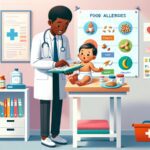Environmental allergies in toddlers: Identifying and managing symptoms can seem like a daunting task for many parents. As toddlers begin to explore the world around them, their exposure to different environmental allergens also increases, leading to possible allergic reactions. Understanding the signs, triggers, and effective management strategies is crucial for ensuring the well-being of your little ones.
Understanding Environmental Allergies in Toddlers
Environmental allergies occur when the immune system reacts to substances normally harmless to most people. These substances, known as allergens, can include pollen, dust mites, mold, and pet dander. Identifying the specific allergen causing symptoms in toddlers can be challenging, as their environments are constantly changing.
A clear understanding of allergy testing and the common allergens can aid parents and caregivers in preventing and managing these allergic reactions more effectively. By observing your toddler’s responses to different environments and consulting with a healthcare provider, you can pinpoint the triggers and take steps to mitigate them.
Environmental allergies in toddlers: Identifying and managing symptoms
Recognizing the symptoms of environmental allergies in toddlers is the first step towards providing them with relief. Common symptoms include sneezing, runny or stuffy nose, itchy or watery eyes, coughing, and skin rashes. In some cases, these allergic reactions can exacerbate other conditions such as asthma, making early identification and management even more critical.
To manage these symptoms effectively, it’s important to limit exposure to the identified allergens. This could mean using air purifiers to reduce indoor allergens, ensuring regular cleaning to minimize dust and pet dander, or keeping windows closed during high pollen seasons. Additionally, your healthcare provider may recommend over-the-counter or prescription medications to help alleviate symptoms.
Prevention and Management Strategies for Environmental Allergies
Preventing environmental allergies in toddlers involves a combination of reducing exposure to allergens and strengthening their immune response. For instance, introducing a balanced diet rich in fruits, vegetables, and omega-3 fatty acids can support immune health. Moreover, regular cleaning and using hypoallergenic bedding can significantly lower the presence of allergens in your home.
When prevention is not enough, effective management comes into play. Besides medication, consider using saline nasal sprays or drops to relieve nasal congestion. Humidifiers can also add moisture to the air, easing respiratory symptoms. For long-term management, allergen immunotherapy, also known as allergy shots, may be recommended for older toddlers, as it can gradually decrease their sensitivity to allergens.
In conclusion, managing environmental allergies in toddlers requires vigilance and proactive steps by parents and caregivers. By identifying the symptoms early, reducing exposure to allergens, and implementing effective management strategies, you can ensure your toddler enjoys a healthy, happy, and allergy-free environment. For more information on managing allergies and ensuring the safety and health of your little ones, visit our library of resources.













